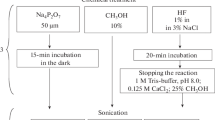Abstract
Fish eggs and larvae can be separated from invertebrate zooplankton by isopycnic centrifugation in gradients of sucrose or silica. Preserved samples of invertebrate zooplankton, fish eggs, and fish larvae, representing a typical assortment of marine plankton, were layered over linear gradients of 25 to 60% w/w (weight/weight) sucrose or 0 to 15% w/w silica (as Ludox AM) in 100 c3 swinging buckets, and centrifuged for 1 h at 1000 rpm (revs per minute). In sucrose gradients, the invertebrate zooplankton were confined to the two ends of the gradient, while 85% of the fish eggs were recovered from an intermediate zone (27.5 to 55% w/w). In Ludox AM, the fish eggs banded in a narrow region between 2 and 3% w/w, while fish larvae banded at the bottom of the gradient between 10 and 14% w/w. Of the 6 dominant classes of zooplankton, only Salpa overlapped appreciably with the fish eggs and none overlapped with the fish larvae. Of the gradient materials tested, Ludox AM offers the most advantages; sucrose may also be useful for subfractionation. Gradients of sodium bromide and dextran have been found to be totally unsuitable.
Similar content being viewed by others
Literature cited
Anderson, N. G.: Method of centrifugal separation and recovery of chemical species utilizing a liquid medium. U.S. Patent No. 3,519,400 (1970).
Bé, A. W. H.: A method for rapid sorting of Foraminifera from marine plankton samples. J. Paleont. 33, 846–848 (1959).
Bonner, W. P., T. Tamura, C. W. Francies and J. W. Amburgey, Jr.: Zonal centrifugation—a tool for environmental studies. Curr. Res. 4, 821–825 (1970).
Lammers, W. T.: Separation of suspended and colloidal particles from natural water. Envir. Sci. Tech. 1, 52–57 (1967).
Linderström-Lang, K.: Dilatometric ultra-micro estimation of peptidase activity. Nature, Lond. 139, 713–714 (1937).
McGowan, J. H. and B. J. Fraundorf: A modified heavy fraction zooplankton sorter. Limnol. Oceanogr. 9, 152–155 (1961).
Miller, C. L. and J. M. Gasek: Drift of drops in density gradient columns. Analyt. Biochem. 1, 78–87 (1960).
Moore, D. H.: Gradient centrifugation. In: Physical techniques in biological research, Vol. II. 2nd ed. pp 285–314. Ed. by D. H. Moore. New York: Academic Press 1969.
Pertoft, H.: Gradient centrifugation in colloidal silica-polysaccharide media. Biochim. biophys. Acta 126, 594–596 (1966).
O. Bäck and K. Lindahl-Kiessling: Separation of various blood cells in colloidal silica-polyvinylpyrrolidone gradients. Expl. Cell Res. 50, 355–368 (1968).
Price, C. A.: Zonal centrifugation. In: Manometric techniques, 5th ed. pp 196–243. Ed. by W. W. Umbreit, R. H. Burbis and J. F. Stauffer. Minneapolis: Burgess Press 1972.
Author information
Authors and Affiliations
Additional information
Communicated by J. Bunt, Miami
Paper of the Journal Series, New Jersey Agricultural Experiment Station, Rutgers University, New Brunswick, New Jersey 08903, USA.
Rights and permissions
About this article
Cite this article
Bowen, R.A., Onge, J.M.S., Colton, J.B. et al. Density-gradient centrifugation as an aid to sorting planktonic organisms. I. Gradient materials. Marine Biology 14, 242–247 (1972). https://doi.org/10.1007/BF00348286
Accepted:
Issue Date:
DOI: https://doi.org/10.1007/BF00348286




